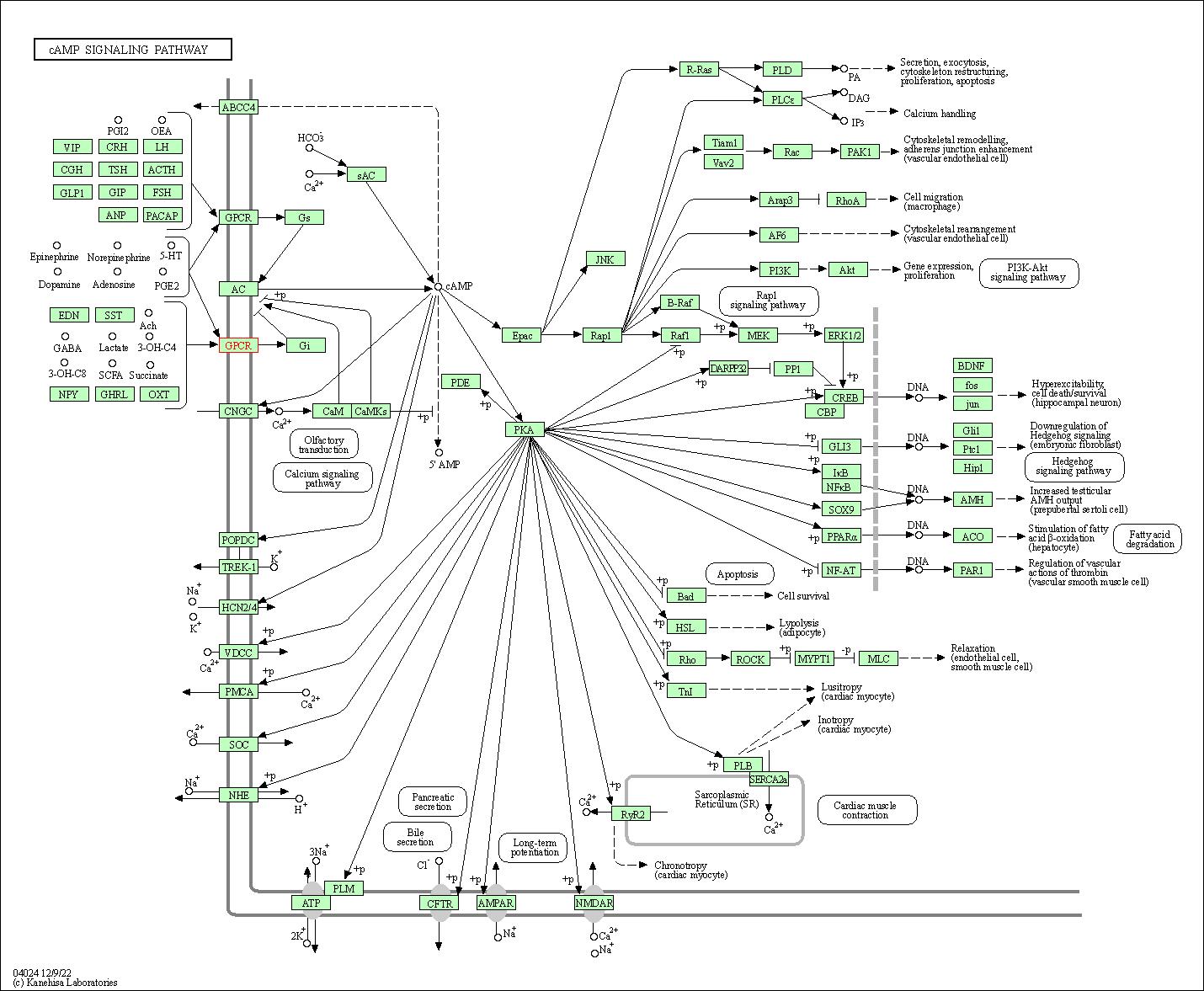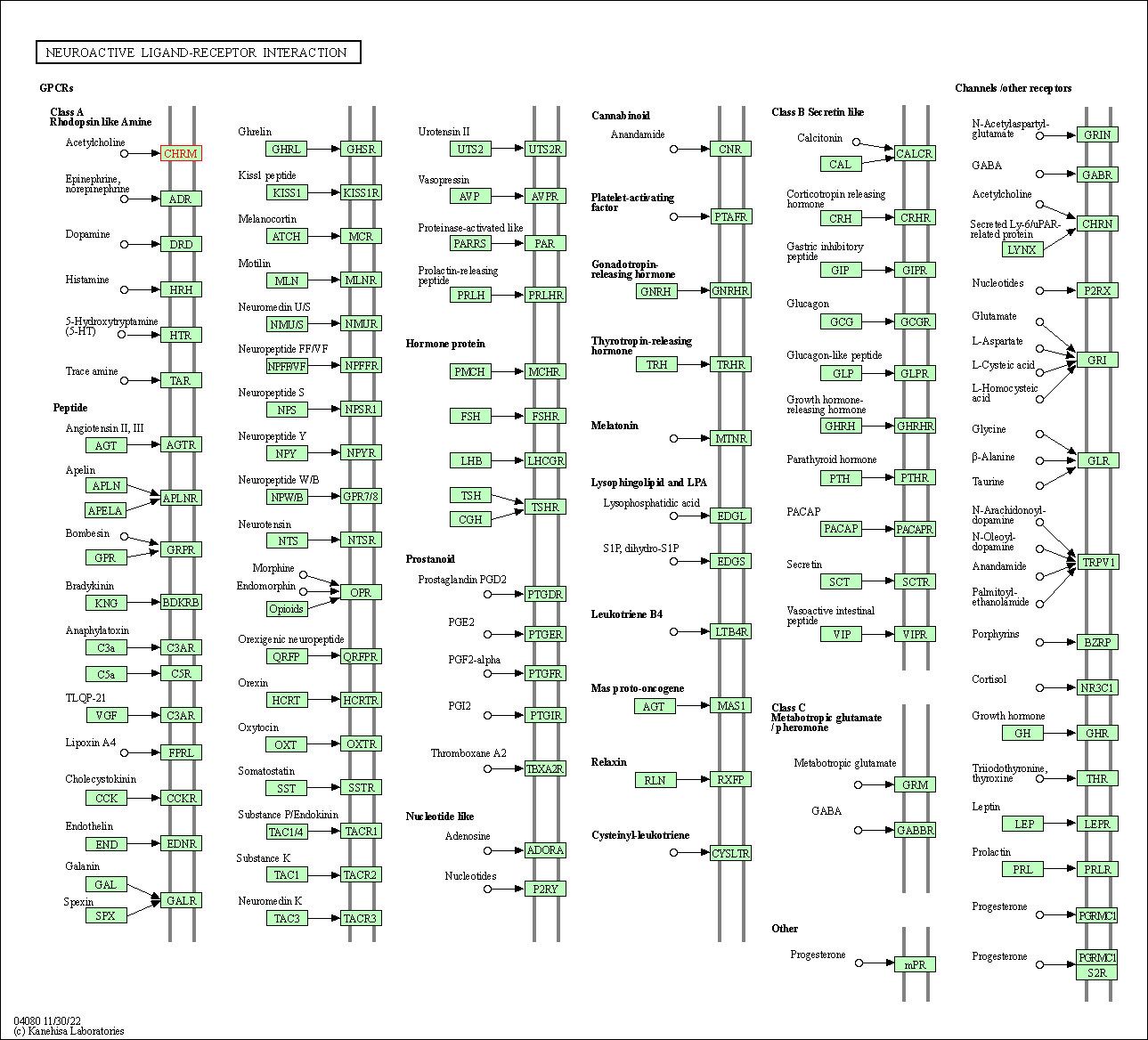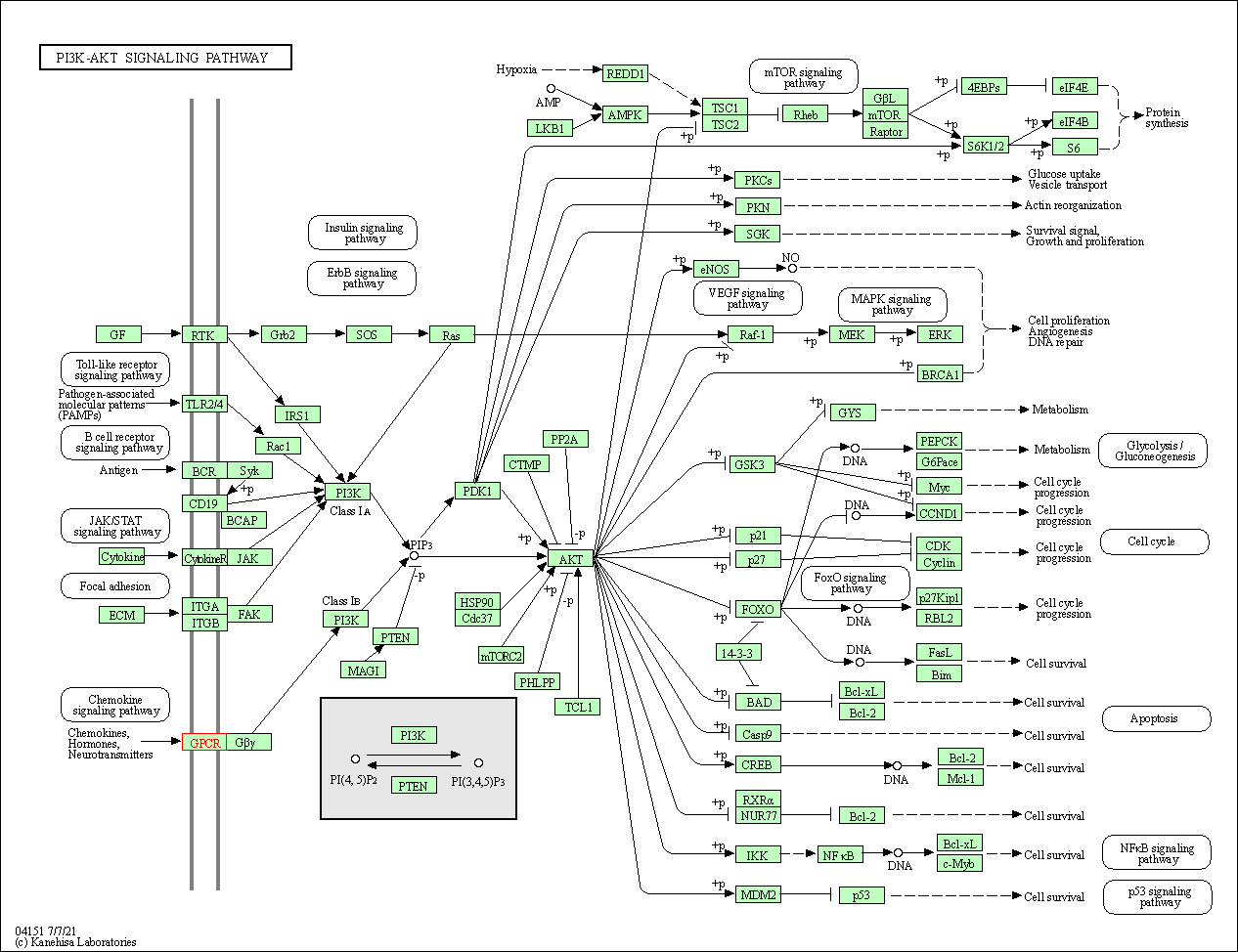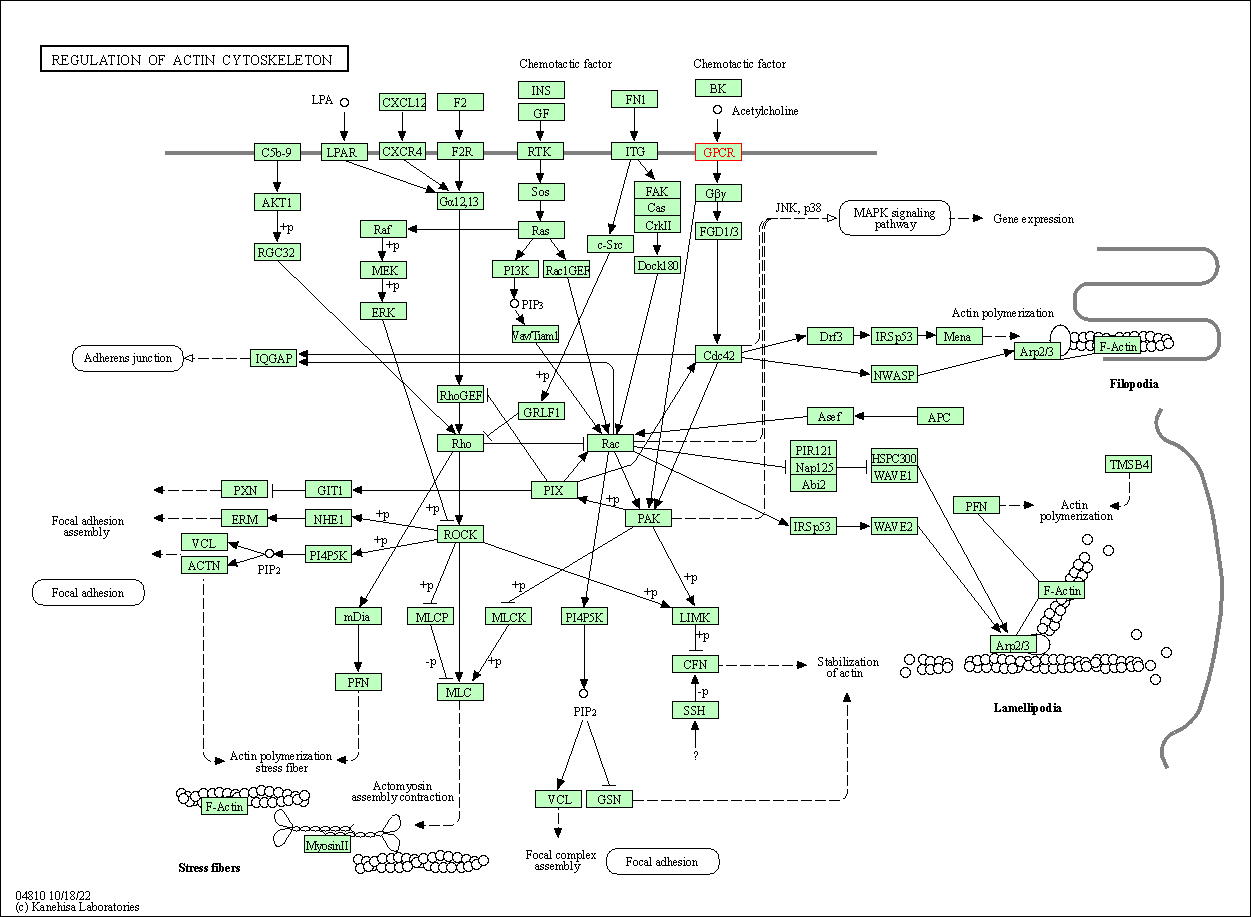Target Information
| Target General Information | Top | |||||
|---|---|---|---|---|---|---|
| Target ID |
T46185
(Former ID: TTDS00003)
|
|||||
| Target Name |
Muscarinic acetylcholine receptor M2 (CHRM2)
|
|||||
| Synonyms |
M2 receptor; CHRM2
Click to Show/Hide
|
|||||
| Gene Name |
CHRM2
|
|||||
| Target Type |
Successful target
|
[1] | ||||
| Disease | [+] 6 Target-related Diseases | + | ||||
| 1 | Asthma [ICD-11: CA23] | |||||
| 2 | Glaucoma [ICD-11: 9C61] | |||||
| 3 | Muscle disorder [ICD-11: FB32-FB3Z] | |||||
| 4 | Peptic ulcer [ICD-11: DA61] | |||||
| 5 | Respiratory system disease [ICD-11: CB40-CB7Z] | |||||
| 6 | Sebaceous gland disorder [ICD-11: ED91] | |||||
| Function |
The muscarinic acetylcholine receptor mediates various cellular responses, including inhibition of adenylate cyclase, breakdown of phosphoinositides and modulation of potassium channels through the action of G proteins. Primary transducing effect is adenylate cyclase inhibition. Signaling promotes phospholipase C activity, leading to the release of inositol trisphosphate (IP3); this then triggers calcium ion release into the cytosol.
Click to Show/Hide
|
|||||
| BioChemical Class |
GPCR rhodopsin
|
|||||
| UniProt ID | ||||||
| Sequence |
MNNSTNSSNNSLALTSPYKTFEVVFIVLVAGSLSLVTIIGNILVMVSIKVNRHLQTVNNY
FLFSLACADLIIGVFSMNLYTLYTVIGYWPLGPVVCDLWLALDYVVSNASVMNLLIISFD RYFCVTKPLTYPVKRTTKMAGMMIAAAWVLSFILWAPAILFWQFIVGVRTVEDGECYIQF FSNAAVTFGTAIAAFYLPVIIMTVLYWHISRASKSRIKKDKKEPVANQDPVSPSLVQGRI VKPNNNNMPSSDDGLEHNKIQNGKAPRDPVTENCVQGEEKESSNDSTSVSAVASNMRDDE ITQDENTVSTSLGHSKDENSKQTCIRIGTKTPKSDSCTPTNTTVEVVGSSGQNGDEKQNI VARKIVKMTKQPAKKKPPPSREKKVTRTILAILLAFIITWAPYNVMVLINTFCAPCIPNT VWTIGYWLCYINSTINPACYALCNATFKKTFKHLLMCHYKNIGATR Click to Show/Hide
|
|||||
| 3D Structure | Click to Show 3D Structure of This Target | PDB | ||||
| ADReCS ID | BADD_A00659 ; BADD_A01381 | |||||
| Drugs and Modes of Action | Top | |||||
|---|---|---|---|---|---|---|
| Approved Drug(s) | [+] 5 Approved Drugs | + | ||||
| 1 | ACECLIDINE | Drug Info | Approved | Glaucoma/ocular hypertension | [2], [3] | |
| 2 | Gallamine Triethiodide | Drug Info | Approved | Stabilize muscle contraction | [4] | |
| 3 | Methacholine Chloride | Drug Info | Approved | bronchial hyperreactivity | [3] | |
| 4 | Methylscopolamine | Drug Info | Approved | Peptic ulcer | [3], [5], [6] | |
| 5 | SMT-D002 | Drug Info | Approved | Seborrhea | [7] | |
| Clinical Trial Drug(s) | [+] 1 Clinical Trial Drugs | + | ||||
| 1 | FP-1097 | Drug Info | Phase 2 | Urinary incontinence | [8] | |
| Discontinued Drug(s) | [+] 6 Discontinued Drugs | + | ||||
| 1 | Otenzepad | Drug Info | Discontinued in Phase 2 | Heart failure | [9], [10] | |
| 2 | PSD-506 | Drug Info | Discontinued in Phase 2 | Overactive bladder | [11] | |
| 3 | SCH-211803 | Drug Info | Discontinued in Phase 1 | Parkinson disease | [12] | |
| 4 | BIBN-140 | Drug Info | Terminated | Alzheimer disease | [16] | |
| 5 | BIBN-99 | Drug Info | Terminated | Alzheimer disease | [17] | |
| 6 | Sch-57790 | Drug Info | Terminated | Alzheimer disease | [18], [19] | |
| Mode of Action | [+] 4 Modes of Action | + | ||||
| Inhibitor | [+] 33 Inhibitor drugs | + | ||||
| 1 | ACECLIDINE | Drug Info | [20] | |||
| 2 | Methacholine Chloride | Drug Info | [22] | |||
| 3 | SCH-211803 | Drug Info | [28] | |||
| 4 | HIMBACINE | Drug Info | [30] | |||
| 5 | 1'-Benzyl-3-phenyl-[3,4']bipiperidinyl-2,6-dione | Drug Info | [32] | |||
| 6 | 1,1-diphenyl-2-(3-tropanyl)ethanol | Drug Info | [33] | |||
| 7 | 1-Methyl-1-(4-pyrrolidin-1-yl-but-2-ynyl)-urea | Drug Info | [34] | |||
| 8 | 2,8-Dimethyl-1-oxa-8-aza-spiro[4.5]decan-3-one | Drug Info | [35] | |||
| 9 | 2-(4-Diethylamino-but-2-ynyl)-isoindole-1,3-dione | Drug Info | [36] | |||
| 10 | 3-(3-benzylamino)-piperidin-2-one | Drug Info | [37] | |||
| 11 | 3-Methyl-7-pyrrolidin-1-yl-hept-5-yn-2-one | Drug Info | [38] | |||
| 12 | 3-Tetrazol-2-yl-1-aza-bicyclo[2.2.2]octane | Drug Info | [39] | |||
| 13 | 4-(4-butylpiperidin-1-yl)-1-o-tolylbutan-1-one | Drug Info | [40] | |||
| 14 | 6-Dimethylamino-2-methyl-hex-4-ynal oxime | Drug Info | [38] | |||
| 15 | 7-Dimethylamino-3-methyl-hept-5-yn-2-one | Drug Info | [38] | |||
| 16 | 7-Dimethylamino-hept-5-yn-2-one | Drug Info | [38] | |||
| 17 | 7-Pyrrolidin-1-yl-hept-5-yn-2-one | Drug Info | [38] | |||
| 18 | A-987306 | Drug Info | [41] | |||
| 19 | Acetic acid 8-aza-bicyclo[3.2.1]oct-6-yl ester | Drug Info | [22] | |||
| 20 | Benzoic acid 8-aza-bicyclo[3.2.1]oct-6-yl ester | Drug Info | [44] | |||
| 21 | BRL-55473 | Drug Info | [45] | |||
| 22 | CARAMIPEN | Drug Info | [46] | |||
| 23 | FLUMEZAPINE | Drug Info | [48] | |||
| 24 | FM1-10 | Drug Info | [49] | |||
| 25 | FM1-43 | Drug Info | [49] | |||
| 26 | GNF-PF-5618 | Drug Info | [50] | |||
| 27 | ISOCLOZAPINE | Drug Info | [51] | |||
| 28 | ISOLOXAPINE | Drug Info | [52] | |||
| 29 | METHOCTRAMINE | Drug Info | [41] | |||
| 30 | N-(4-Dimethylamino-but-2-ynyl)-N-methyl-acetamide | Drug Info | [38] | |||
| 31 | N-methoxyquinuclidine-3-carboximidoyl chloride | Drug Info | [45] | |||
| 32 | Propionic acid 8-aza-bicyclo[3.2.1]oct-6-yl ester | Drug Info | [44] | |||
| 33 | SULFOARECOLINE | Drug Info | [54] | |||
| Antagonist | [+] 5 Antagonist drugs | + | ||||
| 1 | Gallamine Triethiodide | Drug Info | [21] | |||
| 2 | Methylscopolamine | Drug Info | [23] | |||
| 3 | FP-1097 | Drug Info | [25] | |||
| 4 | Otenzepad | Drug Info | [26] | |||
| 5 | Sch-57790 | Drug Info | [31] | |||
| Agonist | [+] 5 Agonist drugs | + | ||||
| 1 | SMT-D002 | Drug Info | [24] | |||
| 2 | CMI-1145 | Drug Info | [47] | |||
| 3 | CMI-936 | Drug Info | [47] | |||
| 4 | Green tea | Drug Info | [47] | |||
| 5 | PTAC | Drug Info | [53] | |||
| Modulator | [+] 4 Modulator drugs | + | ||||
| 1 | PSD-506 | Drug Info | [27] | |||
| 2 | BIBN-140 | Drug Info | [16] | |||
| 3 | BIBN-99 | Drug Info | [29] | |||
| 4 | AF-DX-384 | Drug Info | [42], [43] | |||
| Cell-based Target Expression Variations | Top | |||||
|---|---|---|---|---|---|---|
| Cell-based Target Expression Variations | ||||||
| Drug Binding Sites of Target | Top | |||||
|---|---|---|---|---|---|---|
| Ligand Name: Beta-D-Glucose | Ligand Info | |||||
| Structure Description | Structure of the human M2 muscarinic acetylcholine receptor bound to an antagonist | PDB:3UON | ||||
| Method | X-ray diffraction | Resolution | 3.00 Å | Mutation | Yes | [55] |
| PDB Sequence |
TFEVVFIVLV
29 AGSLSLVTII39 GNILVMVSIK49 VNRHLQTVNN59 YFLFSLACAD69 LIIGVFSMNL 79 YTLYTVIGYW89 PLGPVVCDLW99 LALDYVVSNA109 SVMNLLIISF119 DRYFCVTKPL 129 TYPVKRTTKM139 AGMMIAAAWV149 LSFILWAPAI159 LFWQFIVGVR169 TVEDGECYIQ 179 FFSNAAVTFG189 TAIAAFYLPV199 IIMTVLYWHI209 SRASKSRINI1003 FEMLRIDEGL 1013 RLKIYKDTEG1023 YYTIGIGHLL1033 TKSPSLNAAK1043 SELDKAIGRN1053 TNGVITKDEA 1063 EKLFNQDVDA1073 AVRGILRNAK1083 LKPVYDSLDA1093 VRRAALINMV1103 FQMGETGVAG 1113 FTNSLRMLQQ1123 KRWDEAAVNL1133 AKSRWYNQTP1143 NRAKRVITTF1153 RTGTWDAYPP 378 PSREKKVTRT388 ILAILLAFII398 TWAPYNVMVL408 INTFCAPCIP418 NTVWTIGYWL 428 CYINSTINPA438 CYALCNATFK448 KTFKHLLM
|
|||||
|
|
||||||
| Ligand Name: L-serine-O-phosphate | Ligand Info | |||||
| Structure Description | GPCR-Beta arrestin structure in lipid bilayer | PDB:6U1N | ||||
| Method | Electron microscopy | Resolution | 4.00 Å | Mutation | Yes | [56] |
| PDB Sequence |
TFEVVFIVLV
29 AGSLSLVTII39 GNILVMVSIK49 VNRHLQTVNN59 YFLFSLACAD69 LIIGVFSMNL 79 YTLYTVIGYW89 PLGPVVCDLW99 LALDYVVSNA109 SVMNLLIISF119 DRYFCVTKPL 129 TYPVKRTTKM139 AGMMIAAAWV149 LSFILWAPAI159 LFWQFIVGVR169 TVEDGECYIQ 179 FFSNAAVTFG189 TAIAAFYLPV199 IIMTVLYWHI209 SRASEKKVTR387 TILAILLAFI 397 ITWAPYNVMV407 LINTFCAPCI417 PNTVWTIGYW427 LCYINSTINP437 ACYALCNATF 447 KKTFKECALA497 KD
|
|||||
|
|
||||||
| Click to View More Binding Site Information of This Target with Different Ligands | ||||||
| Different Human System Profiles of Target | Top |
|---|---|
|
Human Similarity Proteins
of target is determined by comparing the sequence similarity of all human proteins with the target based on BLAST. The similarity proteins for a target are defined as the proteins with E-value < 0.005 and outside the protein families of the target.
A target that has fewer human similarity proteins outside its family is commonly regarded to possess a greater capacity to avoid undesired interactions and thus increase the possibility of finding successful drugs
(Brief Bioinform, 21: 649-662, 2020).
Human Tissue Distribution
of target is determined from a proteomics study that quantified more than 12,000 genes across 32 normal human tissues. Tissue Specificity (TS) score was used to define the enrichment of target across tissues.
The distribution of targets among different tissues or organs need to be taken into consideration when assessing the target druggability, as it is generally accepted that the wider the target distribution, the greater the concern over potential adverse effects
(Nat Rev Drug Discov, 20: 64-81, 2021).
Human Pathway Affiliation
of target is determined by the life-essential pathways provided on KEGG database. The target-affiliated pathways were defined based on the following two criteria (a) the pathways of the studied target should be life-essential for both healthy individuals and patients, and (b) the studied target should occupy an upstream position in the pathways and therefore had the ability to regulate biological function.
Targets involved in a fewer pathways have greater likelihood to be successfully developed, while those associated with more human pathways increase the chance of undesirable interferences with other human processes
(Pharmacol Rev, 58: 259-279, 2006).
Human Similarity Proteins
Human Tissue Distribution
Human Pathway Affiliation
|
|
|
Note:
If a protein has TS (tissue specficity) scores at least in one tissue >= 2.5, this protein is called tissue-enriched (including tissue-enriched-but-not-specific and tissue-specific). In the plots, the vertical lines are at thresholds 2.5 and 4.
|
| KEGG Pathway | Pathway ID | Affiliated Target | Pathway Map |
|---|---|---|---|
| Calcium signaling pathway | hsa04020 | Affiliated Target |

|
| Class: Environmental Information Processing => Signal transduction | Pathway Hierarchy | ||
| cAMP signaling pathway | hsa04024 | Affiliated Target |

|
| Class: Environmental Information Processing => Signal transduction | Pathway Hierarchy | ||
| Neuroactive ligand-receptor interaction | hsa04080 | Affiliated Target |

|
| Class: Environmental Information Processing => Signaling molecules and interaction | Pathway Hierarchy | ||
| PI3K-Akt signaling pathway | hsa04151 | Affiliated Target |

|
| Class: Environmental Information Processing => Signal transduction | Pathway Hierarchy | ||
| Cholinergic synapse | hsa04725 | Affiliated Target |

|
| Class: Organismal Systems => Nervous system | Pathway Hierarchy | ||
| Regulation of actin cytoskeleton | hsa04810 | Affiliated Target |

|
| Class: Cellular Processes => Cell motility | Pathway Hierarchy | ||
| Click to Show/Hide the Information of Affiliated Human Pathways | |||
| Chemical Structure based Activity Landscape of Target | Top |
|---|---|
| Drug Property Profile of Target | Top | |
|---|---|---|
| (1) Molecular Weight (mw) based Drug Clustering | (2) Octanol/Water Partition Coefficient (xlogp) based Drug Clustering | |
|
|
||
| (3) Hydrogen Bond Donor Count (hbonddonor) based Drug Clustering | (4) Hydrogen Bond Acceptor Count (hbondacc) based Drug Clustering | |
|
|
||
| (5) Rotatable Bond Count (rotbonds) based Drug Clustering | (6) Topological Polar Surface Area (polararea) based Drug Clustering | |
|
|
||
| "RO5" indicates the cutoff set by lipinski's rule of five; "D123AB" colored in GREEN denotes the no violation of any cutoff in lipinski's rule of five; "D123AB" colored in PURPLE refers to the violation of only one cutoff in lipinski's rule of five; "D123AB" colored in BLACK represents the violation of more than one cutoffs in lipinski's rule of five | ||
| Co-Targets | Top | |||||
|---|---|---|---|---|---|---|
| Co-Targets | ||||||
| Target Poor or Non Binders | Top | |||||
|---|---|---|---|---|---|---|
| Target Poor or Non Binders | ||||||
| Target Profiles in Patients | Top | |||||
|---|---|---|---|---|---|---|
| Target Expression Profile (TEP) | ||||||
| Target-Related Models and Studies | Top | |||||
|---|---|---|---|---|---|---|
| Target Validation | ||||||
| References | Top | |||||
|---|---|---|---|---|---|---|
| REF 1 | The amygdala modulates morphine-induced state-dependent memory retrieval via muscarinic acetylcholine receptors. Neuroscience. 2009 May 5;160(2):255-63. | |||||
| REF 2 | URL: http://www.guidetopharmacology.org Nucleic Acids Res. 2015 Oct 12. pii: gkv1037. The IUPHAR/BPS Guide to PHARMACOLOGY in 2016: towards curated quantitative interactions between 1300 protein targets and 6000 ligands. (Ligand id: 288). | |||||
| REF 3 | Drugs@FDA. U.S. Food and Drug Administration. U.S. Department of Health & Human Services. 2015 | |||||
| REF 4 | Drug information of Gallamine Triethiodide, 2008. eduDrugs. | |||||
| REF 5 | URL: http://www.guidetopharmacology.org Nucleic Acids Res. 2015 Oct 12. pii: gkv1037. The IUPHAR/BPS Guide to PHARMACOLOGY in 2016: towards curated quantitative interactions between 1300 protein targets and 6000 ligands. (Ligand id: 316). | |||||
| REF 6 | Drug information of Methylscopolamine, 2008. eduDrugs. | |||||
| REF 7 | Clinical pipeline report, company report or official report of Summit. | |||||
| REF 8 | Trusted, scientifically sound profiles of drug programs, clinical trials, safety reports, and company deals, written by scientists. Springer. 2015. Adis Insight (drug id 800019662) | |||||
| REF 9 | URL: http://www.guidetopharmacology.org Nucleic Acids Res. 2015 Oct 12. pii: gkv1037. The IUPHAR/BPS Guide to PHARMACOLOGY in 2016: towards curated quantitative interactions between 1300 protein targets and 6000 ligands. (Ligand id: 309). | |||||
| REF 10 | Trusted, scientifically sound profiles of drug programs, clinical trials, safety reports, and company deals, written by scientists. Springer. 2015. Adis Insight (drug id 800001216) | |||||
| REF 11 | Trusted, scientifically sound profiles of drug programs, clinical trials, safety reports, and company deals, written by scientists. Springer. 2015. Adis Insight (drug id 800022973) | |||||
| REF 12 | Trusted, scientifically sound profiles of drug programs, clinical trials, safety reports, and company deals, written by scientists. Springer. 2015. Adis Insight (drug id 800015639) | |||||
| REF 13 | URL: http://www.guidetopharmacology.org Nucleic Acids Res. 2015 Oct 12. pii: gkv1037. The IUPHAR/BPS Guide to PHARMACOLOGY in 2016: towards curated quantitative interactions between 1300 protein targets and 6000 ligands. (Ligand id: 8584). | |||||
| REF 14 | Trusted, scientifically sound profiles of drug programs, clinical trials, safety reports, and company deals, written by scientists. Springer. 2015. Adis Insight (drug id 800002261) | |||||
| REF 15 | In vivo muscarinic cholinergic mediated effects of Lu 25-109, a M1 agonist and M2/M3 antagonist in vitro. Psychopharmacology (Berl). 1998 Jun;137(3):233-40. | |||||
| REF 16 | Therapeutic potential of CNS-active M2 antagonists: novel structures and pharmacology. Life Sci. 1993;52(5-6):497-503. | |||||
| REF 17 | Trusted, scientifically sound profiles of drug programs, clinical trials, safety reports, and company deals, written by scientists. Springer. 2015. Adis Insight (drug id 800002066) | |||||
| REF 18 | URL: http://www.guidetopharmacology.org Nucleic Acids Res. 2015 Oct 12. pii: gkv1037. The IUPHAR/BPS Guide to PHARMACOLOGY in 2016: towards curated quantitative interactions between 1300 protein targets and 6000 ligands. (Ligand id: 350). | |||||
| REF 19 | Trusted, scientifically sound profiles of drug programs, clinical trials, safety reports, and company deals, written by scientists. Springer. 2015. Adis Insight (drug id 800011087) | |||||
| REF 20 | Design, synthesis, and neurochemical evaluation of 5-(3-alkyl-1,2,4- oxadiazol-5-yl)-1,4,5,6-tetrahydropyrimidines as M1 muscarinic receptor agonists. J Med Chem. 1993 Apr 2;36(7):842-7. | |||||
| REF 21 | Cholinergic regulation of the corpora allata in adult male loreyi leafworm Mythimna loreyi. Arch Insect Biochem Physiol. 2002 Apr;49(4):215-24. | |||||
| REF 22 | 6beta-Acetoxynortropane: a potent muscarinic agonist with apparent selectivity toward M2-receptors. J Med Chem. 1998 Jun 4;41(12):2047-55. | |||||
| REF 23 | Methylacridinium and its cholinergic properties. Neurotox Res. 2009 Nov;16(4):372-7. | |||||
| REF 24 | Demonstration of bladder selective muscarinic receptor binding by intravesical oxybutynin to treat overactive bladder. J Urol. 2004 Nov;172(5 Pt 1):2059-64. | |||||
| REF 25 | Clinical pipeline report, company report or official report of FemmePharma. | |||||
| REF 26 | Beneficial effect of muscarinic-2 antagonist on dilated cardiomyopathy induced by autoimmune mechanism against muscarinic-2 receptor. J Cardiovasc Pharmacol. 2001 Oct;38 Suppl 1:S43-9. | |||||
| REF 27 | Interpreting expression profiles of cancers by genome-wide survey of breadth of expression in normal tissues. Genomics 2005 Aug;86(2):127-41. | |||||
| REF 28 | Improving the oral efficacy of CNS drug candidates: discovery of highly orally efficacious piperidinyl piperidine M2 muscarinic receptor antagonists. J Med Chem. 2002 Dec 5;45(25):5415-8. | |||||
| REF 29 | Characterization of BIBN 99: a lipophilic and selective muscarinic M2 receptor antagonist. Eur J Pharmacol. 1993 Sep 21;242(1):23-30. | |||||
| REF 30 | Himbacine analogs as muscarinic receptor antagonists--effects of tether and heterocyclic variations. Bioorg Med Chem Lett. 2004 Aug 2;14(15):3967-70. | |||||
| REF 31 | SCH 57790: a novel M2 receptor selective antagonist. Life Sci. 1999;64(6-7):535-9. | |||||
| REF 32 | Synthesis and biological evaluation of [125I]- and [123I]-4-iododexetimide, a potent muscarinic cholinergic receptor antagonist. J Med Chem. 1989 May;32(5):1057-62. | |||||
| REF 33 | Discovery of (3-endo)-3-(2-cyano-2,2-diphenylethyl)-8,8-dimethyl-8-azoniabicyclo[3.2.1]octane bromide as an efficacious inhaled muscarinic acetylch... Bioorg Med Chem Lett. 2009 Aug 15;19(16):4560-2. | |||||
| REF 34 | Urea and 2-imidazolidone derivatives of the muscarinic agents oxotremorine and N-methyl-N-(1-methyl-4-pyrrolidino-2-butynyl)acetamide. J Med Chem. 1992 Aug 21;35(17):3270-9. | |||||
| REF 35 | Synthesis and modeling studies of a potent conformationally rigid muscarinic agonist: 1-azabicyclo[2.2.1]heptanespirofuranone. J Med Chem. 1998 Oct 22;41(22):4181-5. | |||||
| REF 36 | Design of dual acting anticonvulsant-antimuscarinic succinimide and hydantoin derivatives, Bioorg. Med. Chem. Lett. 7(8):979-984 (1997). | |||||
| REF 37 | Designing active template molecules by combining computational de novo design and human chemist's expertise. J Med Chem. 2007 Apr 19;50(8):1925-32. | |||||
| REF 38 | Cholinergic agents: aldehyde, ketone, and oxime analogues of the muscarinic agonist UH5, Bioorg. Med. Chem. Lett. 2(8):803-808 (1992). | |||||
| REF 39 | Synthesis and muscarinic activities of quinuclidin-3-yltriazole and -tetrazole derivatives. J Med Chem. 1992 Apr 3;35(7):1280-90. | |||||
| REF 40 | Discovery of N-{1-[3-(3-oxo-2,3-dihydrobenzo[1,4]oxazin-4-yl)propyl]piperidin-4-yl}-2-phenylacetamide (Lu AE51090): an allosteric muscarinic M1 rec... J Med Chem. 2010 Sep 9;53(17):6386-97. | |||||
| REF 41 | cis-4-(Piperazin-1-yl)-5,6,7a,8,9,10,11,11a-octahydrobenzofuro[2,3-h]quinazolin-2-amine (A-987306), a new histamine H4R antagonist that blocks pain... J Med Chem. 2008 Nov 27;51(22):7094-8. | |||||
| REF 42 | M2/M4 muscarinic receptor binding in the anterior cingulate cortex in schizophrenia and mood disorders. Brain Res Bull. 2005 May 15;65(5):397-403. | |||||
| REF 43 | M2 receptor binding of the selective antagonist AF-DX 384: possible involvement of the common allosteric site. Mol Pharmacol. 1998 Feb;53(2):304-12. | |||||
| REF 44 | 6beta-Acyloxy(nor)tropanes: affinities for antagonist/agonist binding sites on transfected and native muscarinic receptors. J Med Chem. 2000 Jun 29;43(13):2514-22. | |||||
| REF 45 | A novel and selective class of azabicyclic muscarinic agonists incorporating an N-methoxy imidoyl halide or nitrile functionality, Bioorg. Med. Chem. Lett. 2(8):791-796 (1992). | |||||
| REF 46 | Muscarinic receptor binding profile of para-substituted caramiphen analogues. J Med Chem. 1991 Oct;34(10):2984-9. | |||||
| REF 47 | Evaluation of muscarinic agonist-induced analgesia in muscarinic acetylcholine receptor knockout mice. Mol Pharmacol. 2002 Nov;62(5):1084-93. | |||||
| REF 48 | Synthesis and pharmacological evaluation of a series of 4-piperazinylpyrazolo[3,4-b]- and -[4,3-b][1,5]benzodiazepines as potential anxiolytics. J Med Chem. 1989 Dec;32(12):2573-82. | |||||
| REF 49 | Design and synthesis of a fluorescent muscarinic antagonist. Bioorg Med Chem Lett. 2008 Jan 15;18(2):825-7. | |||||
| REF 50 | Nocardimicins A, B, C, D, E, and F, siderophores with muscarinic M3 receptor inhibiting activity from Nocardia sp. TP-A0674. J Nat Prod. 2005 Jul;68(7):1061-5. | |||||
| REF 51 | Chloro-substituted, sterically hindered 5,11-dicarbo analogues of clozapine as potential chiral antipsychotic agents. J Med Chem. 1990 Feb;33(2):809-14. | |||||
| REF 52 | Synthesis of clozapine analogues and their affinity for clozapine and spiroperidol binding sites in rat brain. J Med Chem. 1981 Sep;24(9):1021-6. | |||||
| REF 53 | Function of pulmonary neuronal M(2) muscarinic receptors in stable chronic obstructive pulmonary disease. Am J Respir Crit Care Med. 2001 May;163(6):1320-5. | |||||
| REF 54 | Heterocyclic muscarinic agonists. Synthesis and biological activity of some bicyclic sulfonium arecoline bioisosteres. J Med Chem. 1988 Jul;31(7):1312-6. | |||||
| REF 55 | Structure of the human M2 muscarinic acetylcholine receptor bound to an antagonist. Nature. 2012 Jan 25;482(7386):547-51. | |||||
| REF 56 | Structure of the M2 muscarinic receptor-beta-arrestin complex in a lipid nanodisc. Nature. 2020 Mar;579(7798):297-302. | |||||
If You Find Any Error in Data or Bug in Web Service, Please Kindly Report It to Dr. Zhou and Dr. Zhang.

